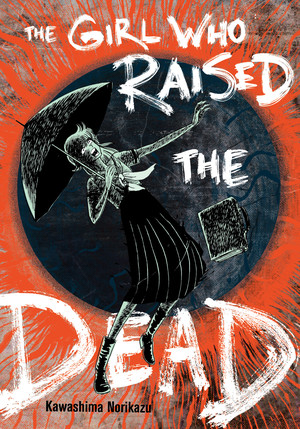The Fall 2025 Manga Guide
The Girl Who Raised the Dead
What's It About?

KRRRAK BOOM!! A young woman is struck dead by a bolt of lightning. But then a miracle-her charred body rises into the air and absorbs an eerie orb of light. When the girl comes back to life, she discovers that she possesses amazing telepathic powers. She can move objects. She can force people to do things against their will. She can see the future. She can even raise the dead!
The Girl Who Raised the Dead has art and story by Norikazu Kawashima. English translation is done by Ryan Holmberg. Published by Living the Line (November 4, 2025). Rated T.
Is It Worth Reading?
Rebecca Silverman
Rating:

It makes sense that The Girl Who Raised the Dead comes from the same creator as Her Frankenstein. After all, what is Frankenstein but a story of reanimation, albeit not of a specific person? This second offering from Norikazu Kawashima and Living the Line isn't quite as horror-centric as the first one, but that works surprisingly well here. After all, raising the dead doesn't have to be a terrible phenomenon – sometimes it's about catharsis.
The eponymous girl is Mirumo, a high school student who goes out in a thunderstorm with an umbrella and is struck by lightning. While she's lying dead in the school, a strange orb enters her mouth, and by some miracle, she's returned to life…with the power to prevent others' deaths. There's no real rhyme or reason as to what her powers can do or how she's “supposed” to use them, which is an interesting approach. Mirumo forces a bully to hurt herself, a child to jump out of the path of a car, and heals the sick. She also gets revenge on killers and uses psychokinesis to hunt down a murderer. The only limit seems to be Mirumo herself and what she believes she can do.
The art isn't gory or gruesome. There are moments, mostly towards the back half of the volume, and that contributes to the idea that Mirumo's power is more of a gift than a curse. Ironically, the one thing she's unable to do is actually raise the dead – it uses too much power, or so she believes. This leads to the idea that perhaps Mirumo's gift is finite, and in using it on random strangers, perhaps she's risking it being unavailable when she truly wants to save someone she loves. It's a tangled web based entirely in her own mind, and if it isn't scary, it's certainly an engaging combination of camp and thoughtful. The story never forgets that Mirumo is a teenage girl, and the ways she uses her powers reflect that.
The Girl Who Raised the Dead is from the 1980s, and that does show. I wouldn't call the art particularly evocative, or even all that pleasing (although the actual horror scenes are much more polished), but the story is fascinating. I don't think it's quite as strong as Her Frankenstein, but it's undoubtedly a formative work in the horror manga landscape, and English language readers are lucky to be able to experience it.
Kevin Cormack
Rating:

I definitely have a soft spot for vintage horror comics, though perhaps the most disturbing thing about this 1987 manga is that it could be called vintage in the first place. Wasn't 1987, like, only a few years ago? (Looks at self in mirror, sees wizened, desiccated body, screams.) Reading very much like a story that might have featured (in less bloody, violent form) in 1970s UK girls' horror comic Misty, The Girl Who Raised the Dead is an unrepentantly daft, meandering tale that remains resolutely charming despite some occasionally janky art.
It's one of those stories that starts with a weird occurrence (main character Mirumo ignores her friends' warnings and steps out into a thunderstorm carrying an umbrella, only to be struck by lightning), and continues to escalate with yet more weirdness until it reaches a crescendo. Mirumo discovers the lightning has bestowed upon her a range of powers, starting small with the ability to cause a bully to harm themselves, to eventually the ability to reattach her own severed limbs, levitate, and even resurrect corpses.
Of course, the whole story is later called into question by the incredibly bleak ending, leading us to question if any of the story ever even happened at all. Tonally, the book is all over the place, partly because of the possibly unintentionally hilarious-looking characters. Mirumo herself is drawn in a fairly normal fashion as a slim, blonde girl with slightly too long limbs. Some of her schoolfriends, however, have such abnormally-shaped features that they look like they belong in a comedy manga.
Similarly, the violence is quite cartoonish, though with great blobs of blood splattering everywhere at appropriately insane moments. It's a rollickingly fun read, though absolutely impossible to take seriously, which is probably why I enjoyed it so much. Essentially, the plot is written as a stream of consciousness with one random vignette blending into the next as Mirumo discovers the next evolution of her powers and wrestles with the decision to keep her abilities secret or not. The eventual appearance of a crazed arsonist and a remote lakeside Friday the 13th Jason-a-like is but icing on the crazy cake.
Delightfully unhinged and entertaining from beginning to end, I thoroughly recommend The Girl Who Raised the Dead to any manga readers who enjoy the loopier side of classic horror.
The views and opinions expressed in this article are solely those of the author(s) and do not necessarily represent the views of Anime News Network, its employees, owners, or sponsors.
discuss this in the forum (22 posts) |
back to The Fall 2025 Manga Guide
Seasonal homepage / archives